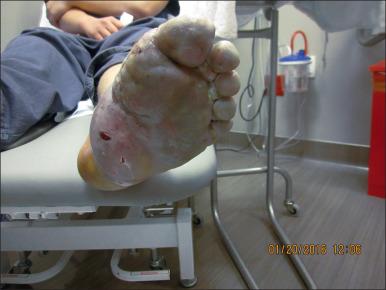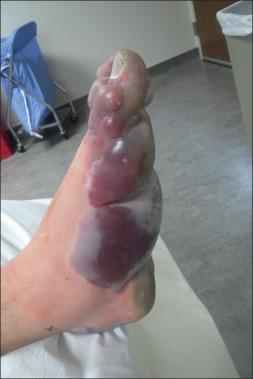Physical Address
304 North Cardinal St.
Dorchester Center, MA 02124
Frostbite is a traumatic injury caused by the failure of normal protective mechanisms against the environment, resulting in freezing of tissue. Cold-induced injury remains surprisingly frequent in the United States owing to increasing interest in outdoor winter recreational activities as well as the common presence of homeless and socioeconomically disadvantaged individuals in large urban centers.
The incidence of and circumstances surrounding frostbite have been documented in numerous military histories. Hannibal lost nearly half of his army of 46,000 soldiers during a 2-week crossing of the Alps due to frostbite injury. During the Revolutionary War, Dr. James Thatcher recorded that Washington lost 10% of his army to cold-related casualties during the winter of 1778. Baron Dominique Jean Larrey produced the first systematic medical observations of frostbite while serving as Surgeon General of Napoleon's forces during the ill-fated invasion of Moscow in the Fall of 1812 and the subsequent retreat in a harsh Russian winter. Because of the epidemic nature of frostbite in this campaign, Larrey was able to create seminal descriptions of frostbite and to identify the debilitating effects of daily refreezing that occurred with bonfire thawing and subsequent marching in frigid conditions; in addition, many soldiers burned their insensate frostbitten feet while attempting to rewarm them over bonfires. Larrey became convinced that the optimal therapeutic management consisted of friction massage with snow or ice, resulting in slow rewarming. These recommendations were maintained as the standard of care for frostbite in military medicine for more than 100 years.
In the winter of 1941–1942, German troops sustained an estimated 250,000 frostbite injuries in the attempt to take Moscow, constituting the largest reported number of related frostbite injuries in history. During World War II both German and Russian troops moved to a philosophy of rapid rewarming based on work conducted at the Kirov Institute in the 1930s. Following World War II existing Russian and German works were translated into English and became the basis for rapid rewarming as the predominant Western paradigm. In 1960, Mills published the first major clinical experience with rapid rewarming and included a philosophy of total care for frostbite with his report. Meryman subsequently edited a seminal text elucidating the scientific bases for frostbite injury. Both military and civilian cold-induced injury data continued to accrue over the subsequent three decades in the absence of any significant clinical advances in the care of frostbite. Frostbite continues to present a tremendous clinical challenge, with the greatest clinical advance coming only in the past decade with the use of thrombolytic therapy in early management.
The injury associated with frostbite results from two broad mechanistic categories: the first is that of direct cellular damage and death due to the cold insult, and the second is the delayed process mediated by progressive tissue ischemia. The immediate effects of frostbite are evidenced by formation of extracellular ice crystals that cause direct injury to the cell membrane, resulting in cellular dehydration due to a change in the osmotic gradient. Rapid cooling results in intracellular freezing, causing more severe cellular damage and cell death, whereas a slower rate of cooling produces extracellular ice crystals. This slower process results in a transmembrane osmotic shift that draws water from within the cell and produces intracellular dehydration. This dehydration causes changes in protein and lipid conformation as well as changes in biochemical processes that are deleterious to intracellular homeostasis. As the temperature continues to fall, intracellular crystals develop, with a loss of the linear relationship of temperature to metabolism, decreased DNA synthesis, and histamine response with skin flushing and development of a fluid-filled wheal.
Microvascular pathophysiology may be even more important than the direct cold injury to the cell, a concept suggested by studies showing the survival of full-thickness skin subjected to freezing and thawing that progressed to necrosis when left in situ but survived when transplanted to a normal, uninjured recipient site. Zacarian identified a number of processes that may play a role in the microcirculatory changes of frostbite. Transient vasoconstriction of both arterioles and venules with subsequent resumption of capillary blood flow appears to occur, and microemboli result from this course. With thawing, the capillaries demonstrate restoration of blood flow that diminishes within minutes. Complete cessation of blood flow is often seen within 20 minutes of rewarming frozen tissue. Similar changes have been seen with random skin flap models after reperfusion, suggesting reactive oxygen species as mediators of injury. Within 72 hours, significant de-endothelialization and deposition of fibrin in the capillary bed occurs. Examination of the endothelial ultrastructure demonstrates swelling, fluid extravasation, endothelial cell dilation, and significant projection of the cell into the vascular lumen prior to cell lysis. There is regional variation in the extent of injury, with low-flow venules being most profoundly affected, resulting in the hypothesis that stasis also plays a role in this pathophysiologic process.
The pathobiochemistry of frostbite has been closely compared to the inflammatory response in the burn wound. Inflammatory mediators such as eicosanoids in burn blister fluid coupled with bradykinin and histamine release in the region of injury draw parallels with findings in cold-induced injury. This has prompted investigators to hypothesize a frostbite soft tissue model similar to that of Jackson's for burns, including zones of necrosis and stasis. Similar to their burn blister analysis, Robson and Heggers examined the fluid in frostbite blisters and found high levels of prostaglandin F 2 and thromboxane B 2 . These agents or their precursors have been implicated in vasoconstriction and leukocyte adherence. In addition, when refreezing follows thawing, the cellular damage caused by ice crystals and the subsequent inflammatory response are exaggerated.
In many situations, the patient is unaware that frostbite is occurring. The presence of hypothermia and the frequent use of mind-altering substances by frostbite patients may contribute to this problem. Typical distribution of injury is acral, with injuries to ears, nose, cheeks, and penis also being fairly common. The patient may note insensitivity and clumsiness of the affected part. This complex of symptoms rapidly reverses upon rewarming. Severe pain occurs during and immediately after the rewarming process, is often described as throbbing in character, and typically requires parenteral opioids for relief.
Because of the nature of freezing injury, classification has traditionally been based on physical examination findings that occur after rewarming. The most common presentation of frostnip is numbness and pallor of exposed skin. Frostnip does not include injury to the underlying dermis or soft tissues, so rewarming results in near-complete resolution of symptoms and physical findings. In contrast, true frostbite involves some degree of dermal and soft-tissue injury. Clinical appearance evolves over a period of time after rewarming, although the initial appearance may be deceptive because hyperemia is present in both frostbite and frostnip. The development of skin blebs may require hours to days from the time of injury. After 12–24 hours, the character of the blebs usually becomes apparent and an assessment of the severity of involvement can allow for management planning for the injury.
Traditional classification of frostbite is similar to that of burn injury. First-degree injury is superficial, with hyperemia in the absence of vesicles or blebs. There may initially be an area of pallor with surrounding erythema that evolves into general edema and erythema without long-term sequelae. Second-degree injury has associated light-colored blisters and subsequent epidermal sloughing. This may correlate with partial dermal involvement but has a generally favorable prognosis. Third-degree frostbite typically has hemorrhagic blisters that evolve into thick, black eschar over 1–2 weeks. Fourth-degree injury involves bone, tendon, or muscle and uniformly results in tissue loss. Precision in depth of injury cannot be expected from visual inspection, and some favor a more general classification of superficial (first- and second-degree injury, see Fig. 39.1 ) or deep (third- and fourth-degree, see Fig. 39.2 ) frostbite injury; clinically, these can be delineated by clear vesicles, present with superficial injury or hemorrhagic blisters indicative of structural damage to the subdermal tissues. Cauchy most recently proposed an alternative classification system based on risk of amputation that includes the extent of the lesion immediately after rewarming, findings from bone scan on day 2, and the presence of blisters on day 2. Although this system has not come into widespread use, the relationship of objective findings to prognosis may prove helpful for future therapeutic trials in the management of frostbite.


Become a Clinical Tree membership for Full access and enjoy Unlimited articles
If you are a member. Log in here